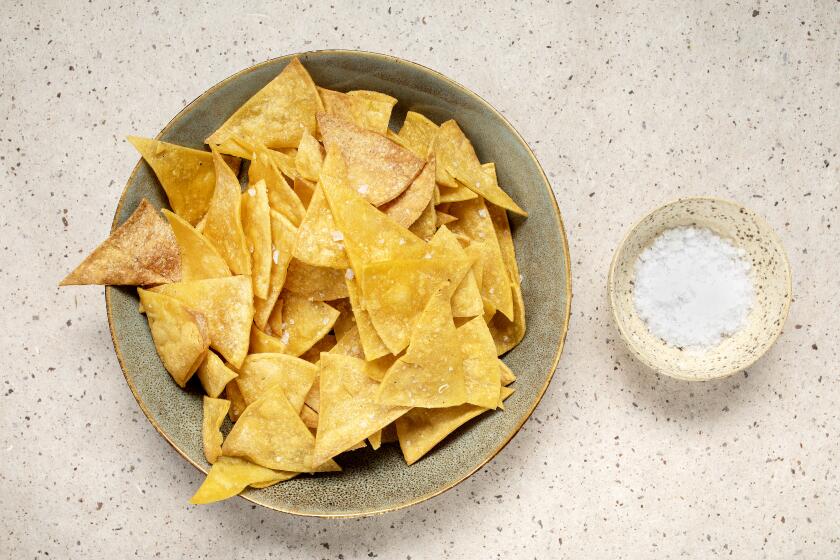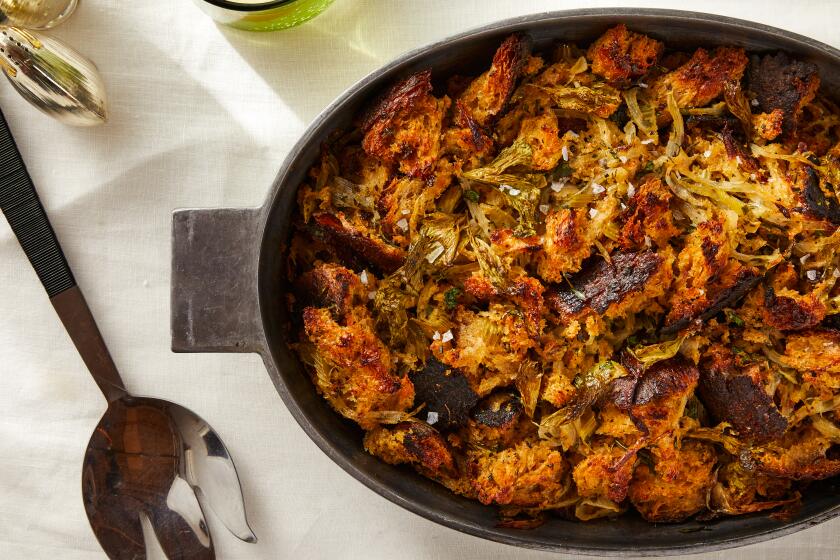Brick oven-style bread
- Share via
Baking bread is a race between the expanding force of the carbon dioxide produced by the yeast, which makes bread rise, and the stiffening of the crust as it dries, which keeps the loaf from expanding. You’re rooting for the expansion to run ahead of the stiffening as long as possible, which will give a nice, high loaf.
The brick oven -- an ancient invention that’s still the best baking environment -- does this beautifully because it’s a sealed chamber. The water that evaporates from the heated dough stays in the oven, keeping the air moist and steamy, so the crust stiffens slowly.
But the home oven is not sealed -- it’s heated by a continuous blast of hot air rushing through it, which sweeps that steam up the vent pipe. So the crust stiffens up early, and either the bread comes out heavy or the crust splits wide open late in baking and you get a rock-hard shell of a crust with an unshapely bulge of over-risen crumb (which will stale quickly, since there’s no crust to protect it).
Another of the brick oven’s virtues is that it’s a “falling” oven. It’s heated all at once, by burning wood or charcoal in it; the fuel is raked out before the bread goes in, so the temperature gradually falls during baking. This also slows down the stiffening of the crust. You can reduce your oven temperature during baking, that’s easy enough. The problem is the lack of a steamy oven atmosphere. Some home bakers put a pan of water into the oven in the hope that this will create sufficient steam, but it’s only moderately effective.
The late Elizabeth David suggested a much better technique, because it recreates the environment of the ancient brick oven. It’s to put the bread on a cookie sheet or pizza brick, rather than an oven rack, and cover it with a lid that can withstand oven temperatures. There’s your sealed chamber full of steam.
Dedicated covers of this sort (sometimes called baking bells or cloches) are commercially available, but you don’t need to buy one. A stock pot or a stew pot will do the same job. Your range still won’t look like a brick oven, but you’ll be working in that same ancient tradition.
Dissolve the yeast in 1/4 cup of the water in a large bowl. When it starts to foam, stir in the remaining water. Combine 3 cups of the all-purpose flour with the whole-wheat flour and salt. Add to the yeast mixture, stirring until blended. Beat in additional flour as necessary to form a ball.
Knead the dough on a floured board until smooth and elastic, 10 minutes. Transfer to a greased bowl and cover ith plastic wrap and a towel; let rise in a warm place until double in volume, 1 1/2 to 2 hours.
Punch down and form into a ball. Roll it in flour; set on a baking sheet sprinkled with 2 tablespoons of cornmeal. Cover with an inverted pot 9 inches or more in diameter. Leave in a warm place 1 hour.
Remove middle rack from oven; place a pizza stone on bottom rack. Sprinkle remaining cornmeal on the stone. Heat oven to 450 degrees.
Remove the pot from the bread and make several slashes on the top of the bread with a sharp knife. Slide the bread onto the hot stone. Replace the pot. Bake 15 minutes. Reduce the heat to 400 degrees and bake 15 minutes longer. Remove the pot. Continue baking until browned and the crust just begins to smell like toast, 25 to 30 minutes longer.
Get our Cooking newsletter
Get a taste of Los Angeles — and the world — with recipes and kitchen tricks from the L.A. Times’ Cooking newsletter.
You may occasionally receive promotional content from the Los Angeles Times.















